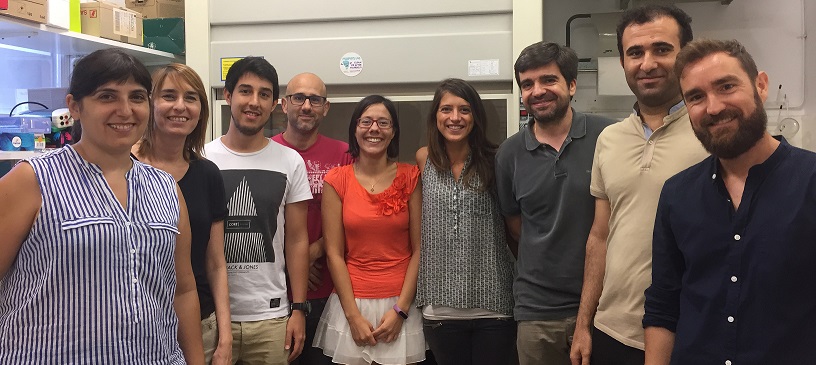CDF15 cytokine, a promising therapeutic target against type 2 diabetes

A team led by Professor Manuel Vázquez-Carrera, from the Faculty of Pharmacy and Food Sciences and the Institute of Biomedicine (IBUB) of the UB, has conducted a review study on the Growth Differentiation Factor 15 (GDF15) —a protein expressed under physiological stress conditions— and its potential impact on the treatment for type 2 diabetes. The study, published in the journal Trends in Endocrinology and Metabolism, gathers the most recent research studies on the functioning of this cytokine, which consolidate it as a potential therapeutic target against this disease.

A team led by Professor Manuel Vázquez-Carrera, from the Faculty of Pharmacy and Food Sciences and the Institute of Biomedicine (IBUB) of the UB, has conducted a review study on the Growth Differentiation Factor 15 (GDF15) —a protein expressed under physiological stress conditions— and its potential impact on the treatment for type 2 diabetes. The study, published in the journal Trends in Endocrinology and Metabolism, gathers the most recent research studies on the functioning of this cytokine, which consolidate it as a potential therapeutic target against this disease.
“This review gathers the latest novelties on the metabolic effects of GDF15 in the context of type 2 diabetes, which are an important turn of what we knew to date. The findings in animal models are specially encouraging and they show that GDF15-based therapies are promising for the treatment of this disease, although we need more clinical studies on humans to confirm it”, notes Manuel Vázquez-Carrera, also researcher at the Research Institute Sant Joan de Déu (IRSJD) and at the Biomedical Research Networking Center in Diabetes and Associated Metabolic Disorders (CIBERDEM).
Benefitial effects on the metabolism
Type 2 diabetes is a complex metabolic disease characterized mainly by an excessive amount of glucose in the blood due to the bodyʼs inability to produce insulin or to use it in the wrong way. In situations of intracellular organelle stress such as the ones caused by this and other diseases, the cells secrete stress-sensitive cytokines such as GDF15, which activate mechanisms to counteract processes like inflammation or insulin resistance.
Recent studies have shown that these beneficial effects on the metabolism are produced through the activation of the GFRAL receptor in the brain: once it is activated, the intake is reduced and, as a result, there is weight loss, which would reduce the obesity and would improve associated diseases such as type 2 diabetes. However, new evidence gathered in this review show that GDF15 can have effects mediated by other peripheral receptors that contribute to improve metabolic diseases.
“To date, it was thought that the GDF15 effects were mediated exclusively by this GFRAL central receptor with an expression restricted to the neurons in the postrema area and the nucleus of the solitary tract, areas of the brain that are involved in the control of hunger and regulation of body weight”, notes the researcher. “Now, it has been shown that the GDF15 has beneficial effects such as the increase in thermogenesis, lipid catabolism and mitochondrial oxidative phosphorylation regardless of the changes in the food intake, which suggests that the GDF15 could also exert its effects through receptors other than GFRAL and independently of the reduction in hunger.
According to the researchers, the discovery of the potential peripheral receptors responsible for this metabolic effects of GDF15 can “help to better understand how this stress cytokine works and to facilitate its pharmacological modulation”.
Metabolismʼs alternative pathway
In this regard, the team led by Manuel Vázquez-Carrera has made important advances regarding the functioning of GDF15 in the metabolism. In a previous study, they found that this cytokine activates AMPK kinase, which regulates many processes related to the cellular energy metabolism such as the increase in glucose uptake and oxidation of fatty acids, the increase in the mitochondrial oxidative capacity and the improvement of insulin sensitivity. This activation occurs independently of the brain GFRAL receptor, showing an alternative way of the energy metabolism regulated by GDF15.
"This kinase is a key regulator of metabolism and is a fundamental therapeutic target for the treatment of type 2 diabetes, since metformin, the drug of first choice for this disease, activates AMPK. These results seem to indicate that part of the anti-diabetic effects of GDF15 could be mediated by the activation of AMPK", stresses the researcher.
New therapeutic challenges
The function of GDF15 as an appetite suppressant and a regulator of energy metabolism has opened the door to the possibility of pharmacologically administering GDF15 to treat type 2 diabetes. However, researchers warn that the pharmacokinetic and physicochemical properties of GDF15 present several challenges for its development as a drug, such as the short average life when it is administered subcutaneously or some adverse effects.
These obstacles have led to the development of GDF15 analogues, that is, structurally similar chemical compounds that aim to improve the efficacy and pharmacokinetics of GDF15 for the treatment of diabetes. "In fact, some of these GDF15 analogues have already entered clinical trials", say the researchers in the study.
Another potential therapeutic strategy has emerged from the recent discovery of the effects of MT1-MMP, a type of protein capable of suppressing the impact on appetite of GDF15 in the context of obesity. "This discovery opens the door to designing MT1-MMP inhibitors to potentiate the GDF15-GFRAL pathway and its appetite-reducing effects. Therefore, the steps to be taken in the future will be aimed at determining the effectiveness and safety of GDF15 or possible analogues or inducers of this cytokine", they conclude.
Reference article:
Aguilar-Recarte, D.; Emma Barroso, E.; Palomer, X.; Wahli, W.; Vázquez-Carrera, M. «Knocking on GDF15ʼs door for the treatment of type 2 diabetes mellitus». Trends in Endocrinology and Metabolism, September 2022. DOI: https://doi.org/10.1016/j.tem.2022.08.004
